In Autumn, the not-too-hot/not-too-cold weather whets the appetite and is ideal for outdoor fun. From weddings to football games, festivals to foliage, the calendar is crowded with activities.
Did you know it’s also the favorite time for pies?
According to Michele Stuart of Michele’s Pies people want pie in the fall. Apple, pumpkin, and pecan, this great trinity of fall pies is not only for Thanksgiving. Demand picks up as soon as the weather turns cool. Michele’s shop, at 666 Main 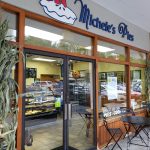 Avenue in Norwalk (next to Walmart), is a hub of the local pie scene.
Avenue in Norwalk (next to Walmart), is a hub of the local pie scene.
When I say pie, I’m talking about a round, double-crust, fruit-filled, traditional pie. Of course, I’m also including single crust custard pies, crumb topped pies, and vegetable pies like pumpkin or squash. (For the record, Ritz Cracker pie is not really a pie in my book.) But for this discussion I’ll broaden out my definition to galettes and crostadas, which are essentially single crust pies with no pan.
Pie is pretty simple on the face of it. There’s just crust and filling. But things quickly get complicated, and discussion can get heated.
In The Art of the Pie author Kate McDermott devotes 68 pages to “How to Make Pie Dough.” She goes on at length about tools, ingredients, techniques, and even decorations. The chapter includes 15 recipes: traditional, gluten-free, and crumble. Crust is pretty serious for McDermott.
Michele, on the other hand, uses her grandmother’s dough recipe. She didn’t share the details, but I gather it’s a pretty unfussy combination of flour, fat, water and salt. She brushes away the arguments about crust with the practiced ease of someone who has mixed tons of dough and rolled out millions of pies in the course of her pie-making career.
It’s the filling that gets Michele’s attention. She uses fresh, local fruit whenever possible. Apples come from Blue Hills Orchard in Wallingford. Cortland are preferred, but to use fresh fruit, she adapts to what’s in season. The apples, tons of apples, are peeled, cored, and cut in the pie shop. Seasoned with just sugar, cinnamon, and nutmeg, the diced apples are piled high under the crust. “You don’t need a lot of sugar with sweet apples right off the tree,” Michele confided.
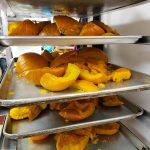 The traditional double-crust Country Apple pie is the best seller at Michlele’s Pies. The Apple Crumb comes in at number two. Apple Caramel Crumb and Apple Cranberry (either under a crust or with crumb topping) are also popular.
The traditional double-crust Country Apple pie is the best seller at Michlele’s Pies. The Apple Crumb comes in at number two. Apple Caramel Crumb and Apple Cranberry (either under a crust or with crumb topping) are also popular.
On the day, I visited the crew was cooking pumpkins from Jones Family Farm in Shelton for pie filling. The kitchen was filled with fragrant steam, pumpkins were cooling on racks that crowded the workspace, and the stove top was covered in tall pots of simmering water. Michele is serious about her pie filling flavors. Traditional pumpkin pie is the best seller, but it can also be had with maple-pecan streusel
 It’s this extra care that has earned her 36 first place ribbons in the National Pie Championships over the years. Her signature Chocolate Pecan Bourbon Pie was her first winner — kicking off the string of pie championships.
It’s this extra care that has earned her 36 first place ribbons in the National Pie Championships over the years. Her signature Chocolate Pecan Bourbon Pie was her first winner — kicking off the string of pie championships.
Prize-winning pie is not rocket science for Michele. For her the best pie is hand made with quality ingredients and fresh local fruit.
Experience helps too.
 I recently attempted an apple galette at home — a free-form, rustic pie, baked without a pie pan. For an overall plan and recipe details, I called upon two of the best cooks I know: Julia Child and Jacques Pepin. In their book, Julia and Jacques Cooking at Home, these two titans of the food world discuss classic dishes, compare recipes, debate techniques and present a final collaboration. The recipes are authentic and the banter delightful.
I recently attempted an apple galette at home — a free-form, rustic pie, baked without a pie pan. For an overall plan and recipe details, I called upon two of the best cooks I know: Julia Child and Jacques Pepin. In their book, Julia and Jacques Cooking at Home, these two titans of the food world discuss classic dishes, compare recipes, debate techniques and present a final collaboration. The recipes are authentic and the banter delightful.
Jacques’ crust recipe is easily done in the food processor but always seems to want more water than specified. The idea is to add just enough water to hold it together and to keep the dough tender with minimal mixing.
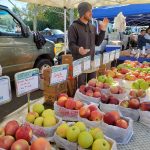 While my dough was resting, I headed to the New Canaan Farmers Market for some fresh, local apples. I asked the wool-hatted farmer from Woodland Farm in Glastonbury for some apples to make a pie, thinking that he would recommend a basket or two of his favorite type. Instead, he grabbed a bag and began tossing in apples from the bins stacked behind the counter. To my surprise, I ended up with a mix of apples, large and small, green and red, tart and sweet, that would make up an orchard blend of flavor.
While my dough was resting, I headed to the New Canaan Farmers Market for some fresh, local apples. I asked the wool-hatted farmer from Woodland Farm in Glastonbury for some apples to make a pie, thinking that he would recommend a basket or two of his favorite type. Instead, he grabbed a bag and began tossing in apples from the bins stacked behind the counter. To my surprise, I ended up with a mix of apples, large and small, green and red, tart and sweet, that would make up an orchard blend of flavor.
The hardest part of home pie making is rolling out the crust. The dough, which can break and tear, should be evenly thick. When making a galette a rough oval will do, no need to worry about the shape of 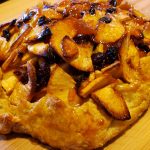 the pan. The apples — peeled, cored, sliced, and tossed with sugar, cinnamon, and some dried cranberries — are “spilled” onto the pastry. The rim is pleated on the fruit and the whole thing goes in the oven for an hour. Golden brown with dark edges, it makes a pretty impressive presentation.
the pan. The apples — peeled, cored, sliced, and tossed with sugar, cinnamon, and some dried cranberries — are “spilled” onto the pastry. The rim is pleated on the fruit and the whole thing goes in the oven for an hour. Golden brown with dark edges, it makes a pretty impressive presentation.
If you have a hankering for pie this fall, don’t be afraid to make your own, it can be very rewarding. On the other hand, go see Michele for one of her award-winning pies. They are dependably delicious and a lot less work.
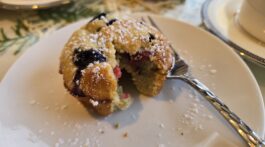







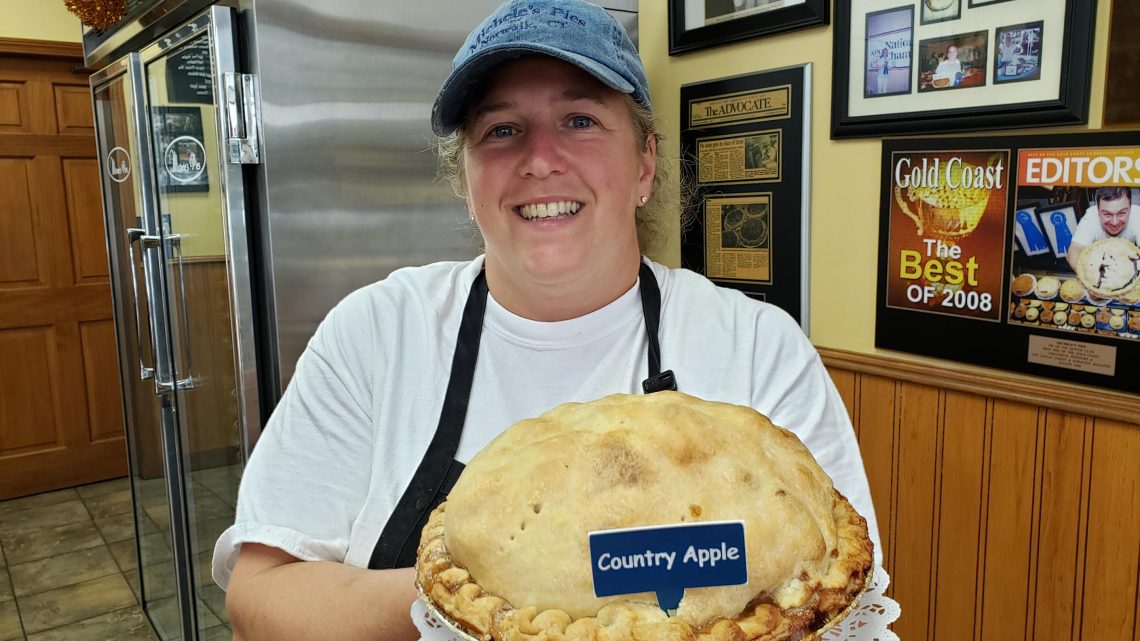
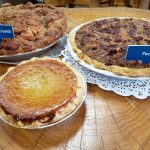
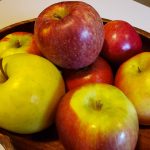



No Comment